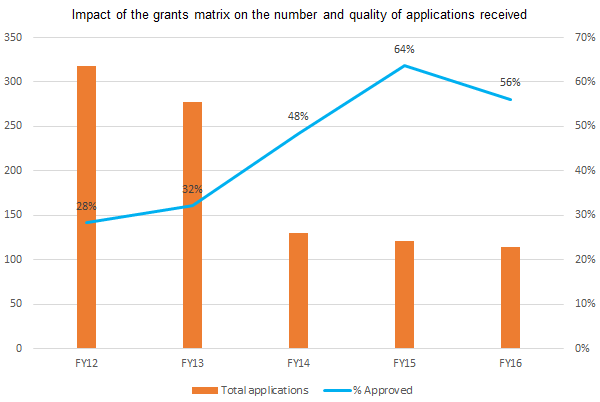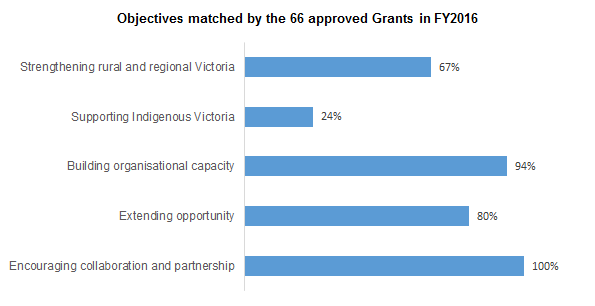The HMSTrust matrix explained
Eligibility is a fundamental prerequisite for funding and an applicant must meet a set of funding criteria specific to HMSTrust.
FY2016 is the third year of the Trust’s matrix-based structure, which has enabled the Trust to work more strategically, with greater efficiencies and to greater effect. The 5 x 5 matrix was developed to be an easy reference for grantseekers. The columns represent the Trust’s five key objectives and the rows, the Trust’s five programs.
Objectives: The proposed project is required to match at least three of HMSTrust’s five key objectives.
Program and focus areas: The project must fall within one of HMSTrust’s five program areas and is required to address at least one of the selected program’s three focus areas, which define the Trust’s areas of interest.
The colour-coded HMSTrust matrix has become a standard feature in all our online case studies. It is a simple device that highlights the objectives and program that a particular grant addresses.

Impact of the HMSTrust matrix
An analysis of grants data over the last five years highlights the impact of the HMSTrust matrix on the quantity and quality of applications received. We have dramatically reduced the number of applications that do not match the Trust’s areas of interest by 64% and effectively increased the approval rate from 28% in FY2012 to 56% in FY2016.
A direct impact of this initiative is that our Grants staff are now able to undertake more thorough due diligence, increase their engagement with grantees and develop greater knowledge and understanding of the broader social sector. The increase in efficiency has also enabled us to allocate more resources into data management and reporting. This data is informing our current grants review, which will take effect from early 2017.

Matching the Trust’s objectives
The requirement for applicants to match at least three of the Trust’s key objectives has been a major influence on the type and quality of applications received. Of the 66 approved grants, 67% of the projects provided direct benefits to rural and regional Victoria; 24% targeted Indigenous communities; 94% identified projects that built organisational capacity; 80% supported projects that reduced inequality for disadvantaged communities; and 100% of the projects were based on significant collaborations and partnerships.
The impact from many of these grants will not be apparent for some time, in particular for capacity building projects. However, there are a few exceptions such as the $30,000 grant to Gallery Kaiela in Shepparton featured as a case study in this Annual Report. This capacity building grant enabled the Gallery to develop a ten-year strategic plan with Social Ventures Australia. The Gallery has subsequently secured, for the first time, four-year operational funding from the State Government and three-year funding from the Federal Government.




